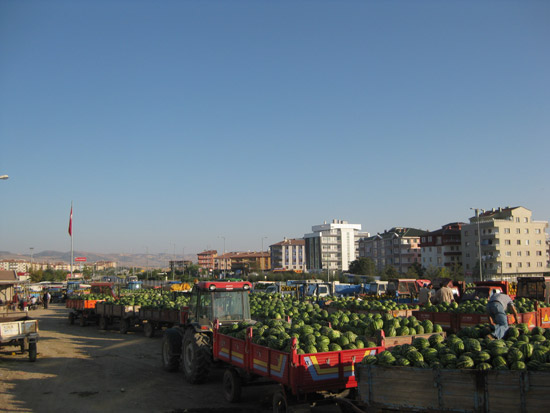What to Eat and Drink in Turkey
My favorite place in any large town is the fruit bazaar, where all this goodness is crammed together into a circus of fragrant, colorful mayhem
/https://tf-cmsv2-smithsonianmag-media.s3.amazonaws.com/filer/20111011110014alastair-bland-cheese-tea.jpg)
I haven’t had a bad tomato yet. In Turkey, the tomato is the foundation of the nation’s cuisine—that or the onion—so it figures that the Turks would do right by this fruit. Elsewhere in Turkey’s fresh produce department, there are few flaws. Produce stands are arranged in beautiful stacks of peaches, nectarines, every kind of melon, apples, pears, figs the size of baseballs, citrus fruits, local avocados, grapes of many colors and so on. There are even bananas, grown along Turkey’s subtropical south coast. Other vendors specialize in nuts, grains, dried fruits and olives, each displayed in barrels. Cheese counters offer a cornucopia of products, including yogurt in bulk, and tasting can be done over the counter as the vendors spoon over samples of each specimen in their inventory. Just about my favorite place in any large town is the central fruit bazaar, where all this goodness is crammed together into a circus of fragrant, colorful mayhem.
But then chefs get their hands on all this wonderful produce. They blast it with heat, oil and salt—and voila! They have reduced Turkey’s finest into greasy mulch and poured it into a display trough in their window, posted with cheap signage reading “Fast Food” or “Kebap” or “Tost.” Bon appétit. I have nothing against chefs. I love chefs. But Turkish cuisine lacks inspiration. Irem and I ate out twice in Istanbul, once at a home-style diner in Beşiktaş, the other in a higher-end destination restaurant called Çiya on the Asian side of the Bosporus. At each place, the food was roughly the same: ready-to-eat stewed vegetables and meats, ordered at the counter and served out of tubs. I, like Irem, eat next to nothing in the way of animals, which puts off limits the ubiquitous kebabs, the fish, the lamb, the rotisserie chickens and the meatballs of Turkey, called köfte.
How to say coffee? Kahve. Not that it really matters since coffee here isn’t coffee; it’s usually Nescafe in a three-in-one packet of instant coffee, artificial milk and sugar. Even that gritty mud called Turkish coffee—called “Greek coffee” one nation west and “Georgian coffee” one nation east—is often reserved for tourists, and in more traditional areas the cafés serve only tea. It comes in thimble-sized cups and runs a little thin for the coffee enthusiast. If you ask for milk in it, the men at the café will object like you’re threatening the sanctity of their nation.
“This is Turkey,” they say. “Tea is black only!”
Tea is an important social tool here. Travelers and passersby in Turkey are often greeted with “Çay!” Several nights ago as I raced darkness to find a place to camp, I waved off three such tea invitations from men at the roadside. One came from a man inside a huge canvas tent, where he sat with his wife on the floor. I caught a glimpse inside as I passed; the light within seemed golden-purple, and the walls and floor gleamed with ornate decorations of Eastern carpet, tapestries and brass-gold trinkets. The man reached out a hand at the sight of me and shouted, almost frantically, “Çay! Çay!”

At a melon loading yard near Ankara, Turkey's finest treasures of summer are piled into trucks.
When shopping, almost everything is placed in plastic bags, which litter the countryside and roadways. Tell the clerk, “No plastic, please,” and a moment of awkwardness may ensue. The shoppers in line behind you and the boys and men who have heeled you curiously through the store now begin to murmur in alarm. The clerk is disheveled. She freezes, holding a crisp, fresh bag, confounded as you wave it away. She tries to grab at your melon, which you seize and place in your bike helmet. “See? No problem,” you say. A man behind you speaks up, hoping to calm the altercation. “Look here, mister. We don’t want any trouble. We’re just trying to get home so we can plop all these wonderful vegetables into a crock for dinner with our families. Why don’t you just have the bag?” “Too much plastic,” you explain. “Plastic, plastic, plastic. On road, in trees, in wind. Central Pacific gyre. Sea turtles. Save the whales!” “Jeepers, now what’s he jabbering about? Nancy, put his doggone melon in the bag!” As often as not, it’s easiest to give in—and a collective sigh of relief swells through the shop.
If you want a drink with your dinner, you must go to the specialty kiosk or tobacco shop, where walls of the licorice-flavored booze raki, vodka and wine surround you. There are two or three types of light, awful lagers typical of subtropical nations, but there is one that I will vouch for: the Efes Xtra strong lager. Rich and malty, it offers subtle hints of hazelnut and a teasing note of cheap canned beer. While it’s perhaps Turkey’s best brew, it scores rock bottom on America’s geekiest beer rating site. Recommended pairing: fresh Sari Lop figs picked from a roadside tree and stuffed with bland white cow cheese.
“And could you double bag that beer, please?”
Want to see where I’ve been on this trip? Check out my map on Tripline.
/https://tf-cmsv2-smithsonianmag-media.s3.amazonaws.com/accounts/headshot/Off-Road-alastair-bland-240.jpg)
/https://tf-cmsv2-smithsonianmag-media.s3.amazonaws.com/accounts/headshot/Off-Road-alastair-bland-240.jpg)